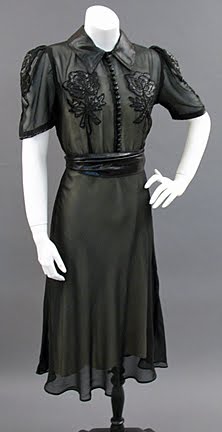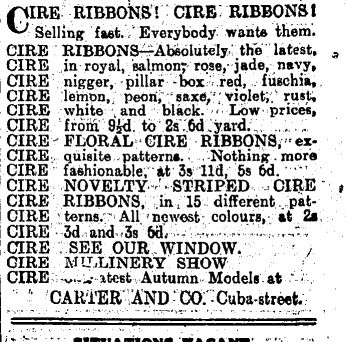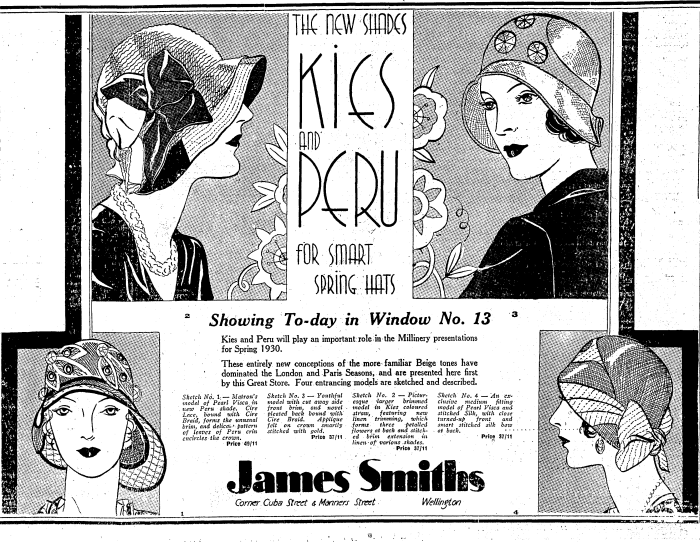Cire is a highly glazed wax finish applied to fabric through a process of heat and pressure, known as calendering (remember calamanco?) which is giving a wet or polished look. The name can also refer to the fabric or garment with the resultant finish. The process tends to produce a stiffer, crisper fabric per weight. It is sometimes, particularly in interior decorating, called a French wax finish.
The term dates to the 1910s, when high fashion garments played with contrasts in fabric and textures, and the shiny, wet look of cire lent an edgy modern twist to combinations of chiffons and brocades and satin.

Dinner dress, House of Drecoll, 1914—16, French, cire silk satin, silk chiffon, fur, Metropolitan Museum of Art, 2009.300.3317
Cire literally means waxed, so the first references to it are to waxed flowers. This Worth evening coat features “a collar of ruched velvet, tied with two ribbons held by a roundels of satin and wax flowers”.
Cire treated fabrics were popular throughout the 20s, particularly as cire ribbons.
Cire reached its zenith in the 30s, when frocks in cire taffeta, cire satin, and even cire lace (ah, a time when shiny lace was a virtue!).

A bias-cut black cire satin evening gown, early 1930s, adorned with two large floral rosettes with gold lame centres embroidered roundels to skirt, and attached belt. Augusta Auctions?

A bias-cut black cire satin evening gown, early 1930s, adorned with two large floral rosettes with gold lame centres embroidered roundels to skirt, and attached belt. Augusta
One of the problems I’ve encountered in researching cire is that few museums note if a fabric has a cire finish or not, so one has to search to identify garments in cire, like this Lanvin extravagance of cire satin:

Cyclone, House of Lanvin (French, founded 1889) Designer- Jeanne Lanvin, 1939, French, silk, spangles, Metropolitan Museum of Art, C.I.46.4.18
Cire’s were popular throughout the 1930s, but like many fashions, they fell out of favour or became hard to source during WWII due to wartime restrictions.

c. 1939 Black silk chiffon dress with cire satin collar and rose appliques on the bodice and sleeves, via Past Perfect Vintage
The original cire fabric were created with a wax finish, but with the introduction of synthetic fabrics after World War II themoplastic fabrics such as nylon and polyester were cired without wax, using only heat and pressure.
Despite the ease of treating synthetic fabrics with a shiny, polished finish, the fell out of favour, though cire cottons returned to fashion in the 1950s, 60s & 70s, often called simply ‘polished cotton.’ It’s still possible to buy cire fabric today, though it may be called by a variety of names.
Sources:
Maitra, K. Encyclopaedic Dictionary of Clothing and Textiles. New Delhi: Mittal Publications. 2007
O’Hara, Georgina. The Encyclopedia of Fashion: From 1840 to the 1980s. London: Thames and Hudson Ltd. 1986
Shaeffer, Claire. Claire Shaeffer’s Fabric Sewing Guide. Iola, Wisconsin: Krause Publications. 2008
Cire: Merriam-Webster Online




Wow, excellent timing. I have that Lanvin gown photo hanging in my cubicle at work and I was just thinking “I would love to reproduce that” I was thinking the fabric would be fairly easy to find, and all the real work would be in that embroidery. Whoops, turns out the fabric is really special too.
Yeah, it’s pretty hard to find these days. But even just in a good taffeta that dress would be amazing!
Weird question: Does it have anything to do with the waxed cotton that serves outdoors clothing?
And I’m amazed how ‘on trend’ this is, what with the coated jeans look, and the ‘wet leather’ look everyone is sporting. It looks almost exactly like it.
Well, the are all in the same family of shiny/waxed fabrics, but cire was done for ornamental reasons, and the oilcloths/early waterproof fabrics were done to protect things from the wet, and were treated in a very different way.
There really is nothing new in fashion is there? Waxed fabrics are in in the 18th century and early 19th, come back in the ’20s, and then they are here again!
I remember ‘polished cotton’ well, from those full-skirted dresses in the late fifties, early sixties. It was rather nice stuff – looked good, pressed well, washed well.
The Lavin dress is stunning! Go, Tracey!
I love the vintage stuff when I can find it. Makes such amazing frocks! Maybe it’s time for a revival? 😉
I remember being fascinated by polished cotton as a kid. It had a sheen, but it wasn’t exactly shiny like polyester. I still think it’s a really nice finish.
You often see this finish on upholstery cottons. Handles well and makes very durable garments….just saying. *smile*
Yes you do! Though in interior design circles it’s known for being a very weak fabric – the polish finish breaks and weakens the yarns, and makes them more prone to ripping. So it’s only used for cushions and drapery, and very light upholstering. Despite it’s weight, it’s not nearly as durable as you would think.
Wow!!! This actually answers a whole slew of questions I’ve been pondering about costumes I see in 1930’s movies! I always see these stunning dresses and gowns, and I guess because of the film quality, they look like they are made of leather. But having looked over the examples you have in the post, they must have all been made from cure finished fabrics.
Am I the only person who paused to comment on the color names? Things certainly have changed. I cannot imagine anyone nowadays selling ribbon and describing the colors as either nigger or peon.
(No negative judgement about this blog post, just a moment of reflection on how even fashion contains a lot of darkness.)